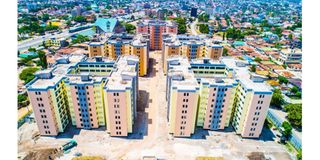As Tanzania urbanises, there is need to create inclusive, livable and sustainable cities

The Magomeni housing complex
What you need to know:
- These are very important areas of reflection by all of us, since, there is all evidence that we are urbanizing and that this process is irreversible.
December, besides being a season of festivities, is also a season of graduation ceremonies. For many institutions of higher learning, a graduation ceremony would be preceded by a number of activities including Convocation meetings and symposiums or seminars.
Ardhi University (ARU) in Dar es Salaam, has a long tradition of training professionals in land-based professionals including land administrators, Valuers, real estate managers, geomatics surveyors, land use planners, architects, quantity surveyors and environmental engineers. The theme for this year’s ARU Convocation Symposium, to be held on Monday 5 December, is appropriate for this column. It is titled: “Quality Living in Urbanising Tanzania: Managing Neighbourhood life in Cities”.
It seeks to reflect on urban social life; the life and experience of living in a town at old age; urban neighborhood lifestyles and community dynamics; urban tourism; and urban living and health. These are very important areas of reflection by all of us, since, there is all evidence that we are urbanizing and that this process is irreversible.
“Back to the village policies” which were espoused as late as the mid-1980s are no longer tenable. Indeed, ours is now called the “Urban Century” as, already, more than half of humankind is living in urban areas.
Tanzania is also urbanizing fast, from at least four processes: rural to urban migration; natural growth of the population already in urban areas; geographical expansion of urban areas, eating into neighbouring rural areas; and transformation of small trade centres into fully-fledged urban areas. The question, which the ARU Convocation Symposium seems to be asking is whether, we, as a country, are prepared for this qualitative transformation of us, from being largely rural, to being largely urban; and whether the city is equipped to look after its senior citizens.
This demands that we reflect on, and go ahead and create sustainable and livable cities. Such a city will have a number of ingredients, prominent among these being the seven itemized below.
First, is a sustainable urban economy providing work, livelihood earning activities and allowing the creation of wealth. People flock to urban areas largely to improve their lot, in terms of earning income. Cities must aim at providing this opportunity through expanding formal employment opportunities, and enabling the proper and sustainable working of the informal sector. Espousing this idea will see public authorities adopting local economic development policies, harnessing all resources to attract economic actors to the city; enlarging the city economic base, and enhancing the city’s competitiveness.
Second, is Social Coherence and Social Solidarity which will see policies avoiding the divide between “us” and “them”. This would mean inclusion of all sections of society: rich, poor; and fighting social and political exclusion. The poor, living in informal settlement must be included in the socio-economic life of the city, and the glaring gap between rich and poor needs to be narrowed.
Third is affordable and decent shelter for all. Fourth is creating a sustainable environment, respecting bio-diversity and aiming at greening the city.
In fifth place is building a livable city characterized by preserving cultural heritage (good for urban tourism) which is very much under threat especially in central city areas, and rejuvenating rundown areas; mixing town and country; as well as the creation of quiet, stress-free, safe and secure streets and neighbourhoods with access to recreational facilities, shops, services and transport.
Livable cities must have an identity and must be inclusive, taking in the interests of the young, the adolescents, the economically active population, the retired, the aged, people with disabilities, and men and women. Green open spaces, for walking, resting, playing exercising and just admiring nature are a crucial component of an inclusive city.
You need high quality sidewalks, where all but all, a child on a bicycle, and an old person with a walking stick can move about everywhere with ease. And, just to remember, human beings were made for walking. Not least, is where to rest our departed ones.
In sixth place is decent, efficient and affordable public transport, based on environmental friendly mass transit. At the same time, non-motorized transport such as walking and cycling must be part and parcel of the city’s development and living.
Last, but not least, there is need for good governance arrangements where city citizens have an influence on what is planned and implemented for them.
The debate on: “Quality Living in Urbanising Tanzania: Managing Neighbourhood life in Cities”, is therefore timely. A question may arise, as to where the urbanizing forum should be, in the national government set-up? The President’s Office, Regional Administration and Local Government (PO-RALG, TAMISEMI) is best placed to develop and implement an Urban Development and Management Policy in the country; and to develop a cadre of urban managers.
It is from such a well-placed angle, that ideas on creating sustainable, inclusive and livable cities, can be implemented.



